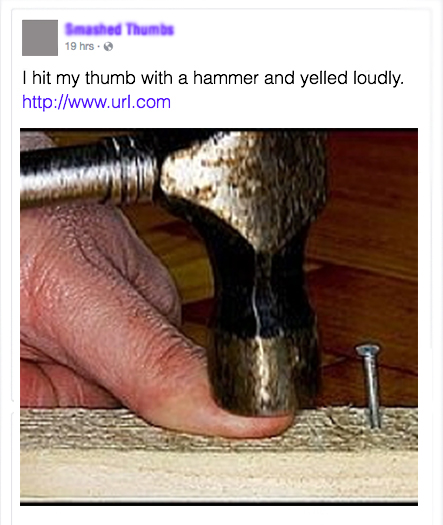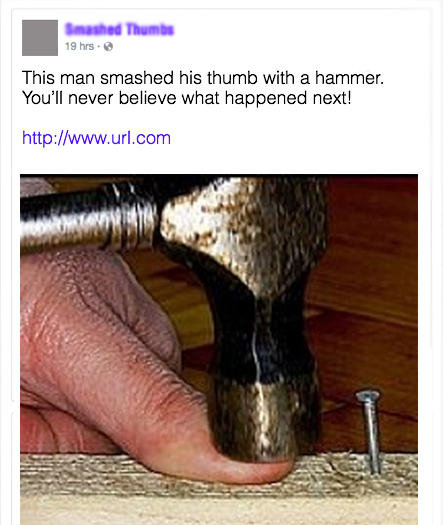Below are two captions for a photo showing a man hitting his thumb with a hammer. One caption tells the whole boring story, with no further exposition needed. The other tells a piece of the story and tries to pique the reader’s curiosity regarding the conclusion.


If the second caption sounds familiar, it’s because it employs wording commonly used in clickbait.
Clickbait ads have two purposes:
- To entice you to click the link, which will take you to the clickbait site
- To keep you on that site as long as possible, often employing lists, known as a listicles
Everyone has seen captions that refer to, for example, a top-10 list, followed by a reference to one particular item on the list: Top Ten Former Child Stars Who Are Homeless! You Won’t Believe Number 8! When you click that link, you are taken to a slow-loading page with a photo of some child star you don’t know. Click Next, and a new slow-loading page shows you photograph number two. This goes on until you get to number eight, which is not the least bit shocking, but since you’ve made it to the eighth photo, you may as well look at all 10, and before you know it you’ve been on the clickbait site for over five minutes.
Clickbait sites are often disguised as news or journalism, although they are neither.
So what is the point of a clickbait site? The purpose of clickbait is to drive numbers, which translate into advertising revenue. A clickbait site provides no useful information and has nothing to sell; it exists only to collect money.
Nearly 80 percent of digital ads are purchased programmatically, and the software doesn’t analyze the content of sites, it only looks at numbers. If a website can boast a high number of hits, with visitors spending considerable time on the site, the software is programmed to buy an ad, even though no one in the advertiser’s target audience will ever see the ad. This misappropriation of advertising funds increases the cost of ads and the cost of products and services.
Short of supporting government regulations, which the online community is loath to do, the only way to eliminate clickbait is to avoid it. Don’t fall for cheesy headlines and learn to recognize the language clickbait sites use to arouse your interest. Additionally, many browsers utilize ad blocker extensions that address clickbait, like Chrome’s Clickbait Blocker.
If your company wants to be certain that ad money isn’t being wasted on fraudulent sites, contact McFadden/Gavender. At McFadden/Gavender, we employ actual humans to place ads, which will ensure your advertising reaches its target audience every time. McFadden/Gavender will never waste your money or your time. Give us a call.



